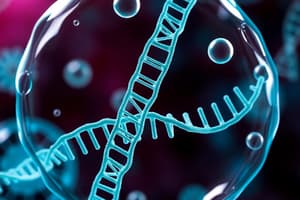Podcast
Questions and Answers
What is the primary function of the Golgi apparatus?
What is the primary function of the Golgi apparatus?
- Packaging and modification of proteins (correct)
- Storage of genetic information
- Protein synthesis
- Production of ATP
Which of the following molecules is involved in the process of translation?
Which of the following molecules is involved in the process of translation?
- DNA
- mRNA
- tRNA
- All of the above (correct)
Which of the following statements accurately describes the relationship between glycolysis and cellular respiration?
Which of the following statements accurately describes the relationship between glycolysis and cellular respiration?
- Glycolysis generates ATP directly, while cellular respiration generates only heat.
- Glycolysis occurs in the mitochondria, while cellular respiration takes place in the cytoplasm.
- Glycolysis is an anaerobic process, while cellular respiration is aerobic. (correct)
- Glycolysis is the only metabolic pathway involved in generating ATP.
Which of the following is true about the structure of DNA?
Which of the following is true about the structure of DNA?
Which of the following events occurs during the process of transcription?
Which of the following events occurs during the process of transcription?
What is the primary function of mitosis?
What is the primary function of mitosis?
Which of the following correctly describes the flow of genetic information in a cell?
Which of the following correctly describes the flow of genetic information in a cell?
Where does the citric acid cycle occur?
Where does the citric acid cycle occur?
Flashcards
Subatomic Particles
Subatomic Particles
The basic building blocks of an atom, including protons, neutrons, and electrons.
Valence Electrons
Valence Electrons
Electrons in the outer shell of an atom that determine its chemical reactivity.
Cellular Respiration
Cellular Respiration
The process by which cells break down glucose to produce ATP, using oxygen.
Glycolysis
Glycolysis
Signup and view all the flashcards
Mitosis Purpose
Mitosis Purpose
Signup and view all the flashcards
DNA Composition
DNA Composition
Signup and view all the flashcards
Gene
Gene
Signup and view all the flashcards
Chromosome
Chromosome
Signup and view all the flashcards
Study Notes
Atomic Structure and Chemical Reactions
- Atoms are composed of subatomic particles (protons, neutrons, electrons).
- Electrons play a role in chemical reactions.
- Valence electrons are crucial in chemical bonding.
- Water is a polar molecule.
Cell Structure and Function
- The cell is the fundamental unit of life.
- Cells have compartments like organelles.
- Ribosomes, Golgi apparatus, and mitochondria are important cell organelles.
- DNA is located within the cell.
Cellular Respiration
- Cellular respiration is how cells obtain energy.
- Glycolysis is a metabolic pathway that converts glucose into pyruvate.
- Glycolysis does not require oxygen.
- Pyruvate is converted to a 3-carbon molecule.
- Citric acid cycle further breaks down pyruvate.
- Electron transport chain is where most ATP is produced.
- Cellular respiration needs oxygen.
DNA and RNA
- DNA is a double-stranded molecule.
- Base pairing in DNA (A-T, C-G) differs from RNA (A-U, C-G).
- DNA is transcribed into RNA for protein synthesis.
- Transcription and translation occur in cells.
- DNA is replicated before cell division.
- mRNA is made in the nucleus, but translation occurs in the cytoplasm.
Cell Cycle and Mitosis
- Mitosis is for cell division.
- Meiosis is important for gamete production.
- DNA replicates before mitosis.
- In DNA, the bases (A, T, C, G) make up the middle part.
- In the DNA helix, Adenine pairs with Thymine and Cytosine pairs with Guanine.
Other Concepts
- Chromosomes are made of DNA wrapped around proteins.
- Genes are segments of DNA that code for proteins.
- Humans have autosomes and sex chromosomes.
Studying That Suits You
Use AI to generate personalized quizzes and flashcards to suit your learning preferences.
Related Documents
Description
This quiz covers fundamental concepts in biology, including atomic structure, the role of valence electrons in chemical reactions, cell structure, function, and the processes of cellular respiration. Test your knowledge on the composition of cells, organelles, and the biochemical pathways that provide cellular energy.




